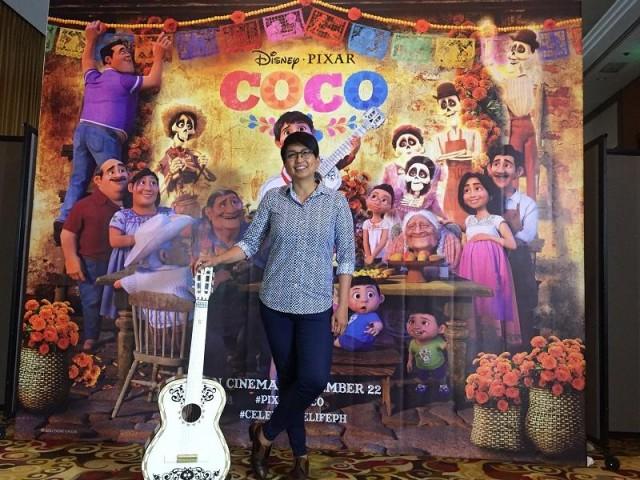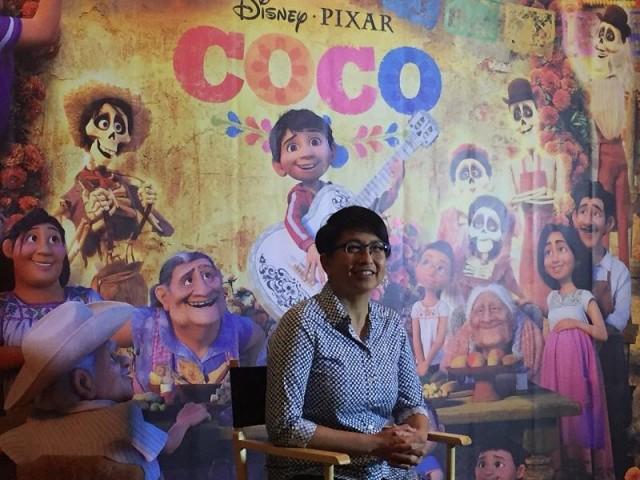Meet the Fil-Am supervising animator of 'Coco', Disney-Pixar's latest
Gini Santos didn't have the full support of her parents when she applied to University of Santo Tomas' fine arts department. Her parents asked her how she would feed herself, how she could live off creating art when it is often a fruitless pursuit.
Decades later, Santos is the supervising animator for Disney-Pixar's latest animation film “Coco”, and a veteran of beloved 3D classics “Finding Nemo”, “Toy Story”, and a “Bug's Life.”
Santos finds the same conflict that she faced in her youth in Miguel, the young protagonist of “Coco” whose family endeavors to stop him from pursuing his dreams in music due to an edict by his great great grandmother.

“My dad was against me being an artist. When I first delared my college, they were like oh no, how are you gonna feed yourself? And then to come to this point where all of a sudden, I'm at Pixar, I'm doing well, and I'm following that dream, I definitely relate to Miguel,” Santos recalled in a roundtable interview at the Marriot on Monday.
She and other production leads under director Lee Unkrich explored Mexico City to create Miguel's world and present with authenticity the aesthetics and tradition in Disney-Pixar's latest flick, to be released in the Philippines on November 22.
All this research culminated in the sprawling colors of Miguel's hometown and the Land of the Dead, the exquisite detailing of the Simulation department for hair, skin and cloth, and some of the most animated background characters in the company's history.
“It's been amazing,” Santos remarked. “I was excited to see the designs really – especially the background characters – I feel like these are some of our best background characters because they really put a lot of detail in the tone of the skin, the color, and even the look, to feel like it's from Mexico.”
“We usually have a standard background, character set we pick from, but we were really very careful to be really respectful of how it felt. It was just amazing to see a lot of that detail being put in, a lot of effort,” she continued.
The animation of the background characters, especially skeletons and the musical performances – which Santos later said took up most of the animation department's time – earned particular praise.
“One of our challenges with the skeletons were, you take away all the skin, it all looks the same. The way we broke them up is through costume, certain features like hats and sizes, and then obviously movement, so that really helped the look of it,” Santos, who handled the primary team, explained.
“As far as giving them more specific business to do, we have a whole second unit team on the show and they do a lot of the crowds, huge population of characters and they actually have a software. They work with the technical side of it where they build software; animation will come in and will do libraries of movement, and then there's a software that will take all that library and apply it to a big scene where they put a lot of characters.
Because for one person to go in there and try to apply that, it'll take forever. It's actually software driven, but the animation comes from us,” she added.
Quite the work was also put in to the skeletal inhabitants of the Land of the Dead, though as Miguel's voice actor Anthony Gonzalez remarked, Santos hopes that the human core of the movie will prevent any frights.
“I heard that in an interview, Anthony had said that, well, kids might be afraid to see them at first, but we're hoping that they would relate to seeing Miguel being another kid interacting with skeletons and hopefully be just be like, if it's okay with Miguel, it should be okay to interacting with skeletons,” Santos said.
The world itself is inspired by practicalities of what it means to have dead persons living in it.
“The architecture that you saw, the design rules on that one is that people have been dying since the beginning of the world so the base of the architecture was something that was like Mayan, which was way back. And because people are always dying, they're always having to build. So each layer of building style changes based on the era, so it gets more modern, and more modern,” she said.
And in its core, the major themes of and depiction of Mexican culture in “Coco” has distinct similarities with Filipino culture, especially when it comes to family.
“It's funny because I feel like Coco, you know the Mexican culture, they kinda share our dynamic a little bit, as family. In the Western world, I feel like first of all, personal space is so big there. Here, our personal space is so small... That was one thing that we knew we wanted to get in there because just studying the Hispanic family, they actually have that same (dynamic),” Santos said.

“We actually had to change our way of thinking and how we had our acting performances in animation because we didn't want it to feel like it was kinda Western animation. We wanted the performance to feel like, oh yeah, it's a family in this small town. I feel like everyone's gonna relate to it just because of the family and how they are with each other,” she contined.
This feeling of familiarity extends to the team that created “Coco”, which exemplified Disney-Pixar's “spirit of collaboration.”
“As supervising animators, we don't tell what the animators should do. We guide them and help them do their work, but we recognize that our team are highly talented animators and they're gonna have great ideas they can bring to the floor. We're just there to kind of shepherd them and making sure they get what they need, they're able to share that information with the director, and the director is able to talk to them,” Santos said.
After three years of creating Miguel and his family, Santos decided to step back from projects being offered to her take a little break and spend more time with her own family.
But before this, she took time to hold an animation workshop for students on Tuesday just to give back and share her two decades' worth of experience in the industry.
Santos noted that even with their easier access to prorgrams and tutorials, animation students must always master the basic principals of drawing and animation to make the toon of their dreams or the reel that will get them through Disney-Pixar's doors.
“Before animation made its leap onto the computer, the original 2D animation, there's the 12 principles of animation and a real animation student would know that,” Santos commented.
“I get this question all the time from students, what am I gonna put in my reel, and I always tell them, it comes down to what we see in the animation. It doesn't have to be polished; we've gotten reels where the animation is rough, but the timing is there, the acting and the beats are clear. It just goes back to your principals of animation, making sure you know that and then applying to whatever the animation is, the character, the acting and we'll see that, even beyond anything else you put on there.” — LA, GMA News




